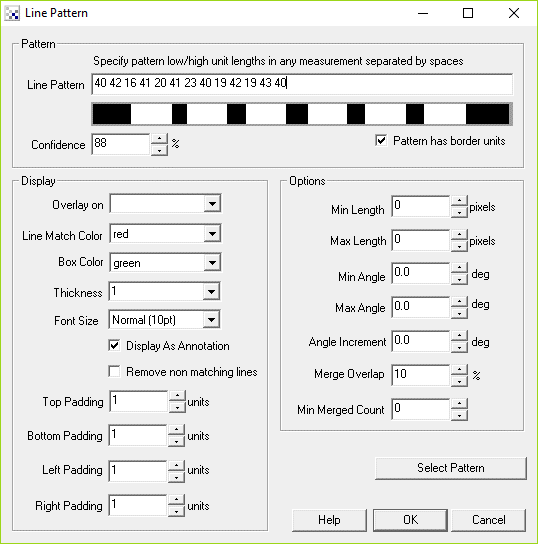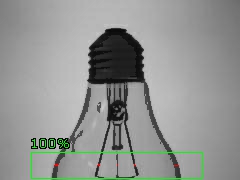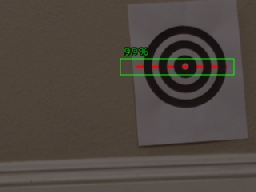
Line Pattern
The Line Pattern module is used to detect specific low/high pixel combinations present within the image not unlike those patterns exhibited by barcodes. While barcodes have their own specific configurations it is often useful to be able to scan for patterns that are not necessarily barcodes but provide a unique pattern within the image. This module can be useful for identifying patterns that are obscured in part due to other objects that would cause complete object identification to fail.This module assumes a black and white image (thresholded) in order to find patterns. If a colored or grayscale image is provided, the module will assume all values below 128 are black and above 128 to be white.
Interface

Instructions
1. Line Pattern - Specify the line pattern using numbers that indicate the expected lengths of light/dark/light/dark/etc. transitions. For example the pattern 2 4 1 4 2 would indicate a white run of 2 units, followed by a black run of 4 units, followed by a white run of 1 unit, etc.
If you have an existing sample of the pattern already loaded you can use the Select Pattern button to indicate the line pattern that you wish to find. Once selected the Line Pattern number sequence will automatically be created based on the selected sample.
2. Visual - The black and white line graphic visually depicts the information in the line pattern data. When the pattern is changed the
2. Pattern has border units - The default pattern mode assumes that is begins on a white pattern with a minimum 1 pixel border. In many cases larger border areas can be used to isolate true patterns form false patterns. By enabling border units the pattern can be augmented with start and stop unit values that specify the minimum space required around the pattern for it to have a high confidence.
3. Confidence - Specify the level of confidence that should be expected for a pattern match to be considered a valid match. The confidence is based on how precisely the image sequence matches the lengths specified in the Line Pattern.
4. Pattern has border Units - Pattern includes border lengths that can be larger than the specified amount but not less than. This allows a pattern to have silent areas around the actual pattern.
5. Overlay on - Specify which image the graphics should be show on. This option allows you to show the source image that generated the pattern.
6. Line Match Color - The color used to indicate which lines match the pattern.
7. Box Color - The color used to indicate the grouping results of the line patterns.
8. Thickness - The thickness of the line used in the box drawing.
9. Font Size - The font sized used to annotate the confidence display.
10. Display as Annotation - Select if you want the graphic to be draw after all processing has been completed. If this is NOT selected then the next module in the processing pipeline will see the graphic as if it were part of the image and process it accordingly.
11. Remove non matching Lines - To remove most of the image that is not matched by the pattern select the "remove" checkbox. This will remove all white lines that do NOT match the pattern. This can be used to isolate the sought out pattern for further processing without any other parts of the image being present.
12. Padding - How much space to include around the line patterns to use in grouping.
13. Min/Max Length - Used to filter line patterns matches that are too small or too long to be valid.
14. Min/Max Angle - The minimum and maximal angles to check for the line pattern.
15. Angle Increment - The increment to use when testing from the minimum to maximum angles. Large numbers will speed up detection but reduce precision.
16. Merge Overlap - Line patterns that are detected next to each other can be grouped to create a single final result. The Overlap percentage specifies how much of the lines need to overlap in order to be merged. 0 % will merge any lines that overlap, 100% will keep them separate.
17. Min Merged Count - The minimum number of merged lines required for a result to be declared. This ensures that there are enough line pattern matches to declare a result and is used to eliminate false matches.
18. Select Pattern - As the creation of the line pattern using just numbers can be difficult, you can press the Select Pattern button which will allow you to specify the line to sample and create the number pattern for you.
Examples

|

|

|

|
Variables
LINE_PATTERN_COUNT - number of found line patterns (combined into a
single overlapping block)
LINE_PATTERN - the results of the pattern match
The array contains blocks of 8 values per detected pattern. The elements
are as follows:
Offset Contents
0 score of the pattern (1-100)
1 x coordinate of the center of the pattern
2 y coordinate of the center of the pattern
3 size in percent * 10 of the detected
pattern relative to the source pattern
4 x start coordinate of the pattern
5 y start coordinate of the pattern
6 x end coordinate of the pattern
7 y end coordinate of the pattern
See Also
Barcode
Shape Match
Fiducial
| New Post |
| Line_Pattern Related Forum Posts | Last post | Posts | Views |
|
Line Pattern variables
The documentation for Line_Pattern says that there are 8 variables returned. When I use the module and examine the re... |
8 year | 2 | 2551 |
